
This page has been visited  times. times.

Mother and Her Pup
Mark Keyworth

Fayetteville, N.C.
United States

Here I am, LoverOfWolves
 Why LoverOfWolves
Why LoverOfWolves
Hi, my name is Mark Keyworth and I bet you are wondering why I chose loverofwolves as a title for my page, because that is what I am a Wolf Lover. The wolf is a majestic animal and a very misunderstood animal, that only wants to be left alone and survive. But we two legged animals in all our infinite stupidity nearly hunted them to extinction. Why?, because we are greedy we want it all, all the land for ourselves instead of sharing. The Wolf was killing sheep and cattle but only after we crowded them and killed all their natural game. We need to learn to co-exist with Mother Natures creatures and protect them, not destroy them. The Wolf along with other nearly extinct creatures are on their way back, and I for one am glad to see it. We need to preserve our wilderness and wildlife for generations to come so they can enjoy, and experience the grandeur of Mother Nature. Lets learn to co-exist with the wolf and other creatures not destroy them, after all this place we call earth was theirs first. This page is dedicated to their reintroduction to the lower 48 States and in particular the Adirondack State Park of New York.

More Useless Facts about me!
I am an outdoor enthusiast, I like Hiking, Camping , Whitewater Rafting and fishing. I love sports both playing and coaching, I coach youth and High School Football and play Lacrosse, Softball, Flag Football, and Basketball or at least I attempt to. I have a gallery of some whitewater rafting pictures of some of the rivers I have rafted so check them out. A 2nd gallery (yet to be constructed) will have some pictures of the Adirondack Park in NY where I am originally from, and future home of the eastern timberwolf. If you want to know more just ask me I'll be around. Please visit some of the links I have at the end of my page and dont forget to sign my guest book. Thanks and enjoy.

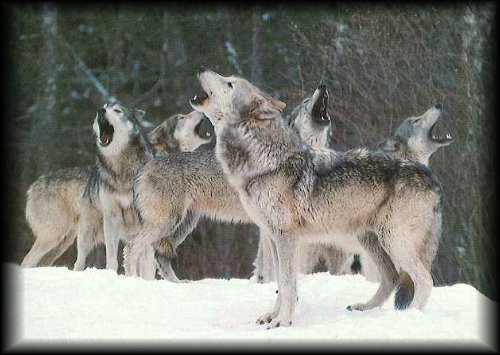
Wolves Song
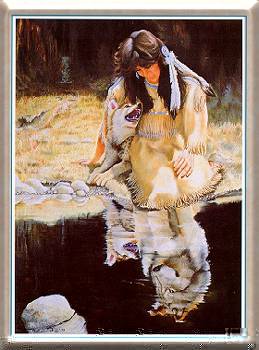
The Looking Glass

Wild Wolf's Lullaby
Out West where desert sands are hot,
By day when winds are dry,
And nights are cool and lighted by,
A sparkling starlit sky.

A child, I slept to serenades,
When desert nights were still,
As wolves wept out there mournful songs,
Up on the moonlit hill.

And deep with in my growing soul,
Their music intertwined,
To haunt the days I am living now,
With years I left behind.

My lonely heart yearns for that sound,
The wild wolf's serenade,
The lullaby that filled my dreams,
When memories are made.
Kate Watkins Furman

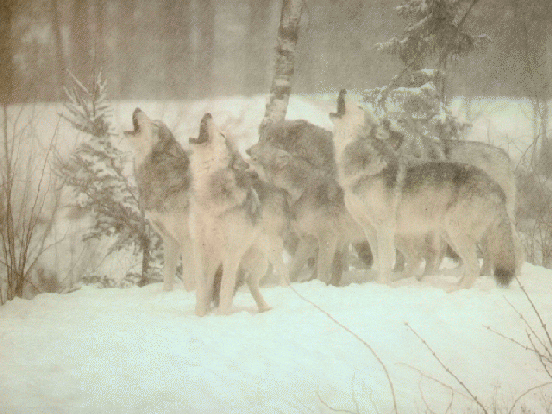
The Pack Howl, A Call of the Wild

Background
Two species of wolves exist in North America; the gray wolf, Canis lupus, and the red wolf, Canis rufus. The historic range of the gray wolf included most of North America, from central Mexico to the Arctic Ocean, except for red wolf habitat in the southeastern United States. As European settlement expanded into wolf habitat, interactions between wolves and humans became more frequent. Several effects of this settlement played and important role in the decline of wolf populations. First was the clearing of forest habitat in the Eastern United States. This was accompanied by a significant over-hunting of deer and elk, the preferred prey of the wolf. Lastly, as settlers turned to raising livestock, fear of depridation led to eradication programs that poisoned, trapped, and shot remaining wolf populations. In 1914, Congress authorized funding for the removal of all large predators, including wolves, from federal lands. By the 1940's, humans had eliminated red and gray wolves from almost all of their historic range in the lower 48 states. In 1967, the timber wolf subspecies Canis lupus lycaon, was listed as endangered under the Endagered Species Preservation Act of 1966. In 1978, the Secretary of the Interior declared the Minnesota population of wolves as threatened and all other North American gray wolf populations south of Canada as endangered with out reference to subspecies.

In 1894, the New York state constitution stipulated that two and a half million acres of the six million acre Adirondack Park, the largest wild area east of the Mississippi, would be "foreverkept as wild forest lands." However, while remaining relatively wild, the park is missing a key component of its ecosystem-the eastern timberwolf.

The Eastern timberwolf(Canis lupus lycaon), a subspecies of graywolf, once reigned as the top predator in the great North Woods. Through selective predation on deer and moose, wolves kept these large plant eaters in balance with the ecosystem, and by reducing the overabundant plant eaters place on forests, wolves played an important role in preserving biodiversity in this region.

Unfortunately the howl of the wolf has not been heard in the Northeast for One hundred years. European settlers harbored a deeply instilled fear of the wolf and persecuted them relentlessly. Beginning in 1630, the Massachusetts Bay Colony and others paid an average months salary for the head of a wolf, encouraging bounty hunters to shoot, poison, and trap this misunderstood and undervalued animal. Bounty records show that the last Northeast wolf was killed in New York in 1897. The wolf has been missing from New York for 100 years.

Scientists believe that the likelyhood of natural recolonization to the Adirondacks is extremely low. Extensive agricultural lands, busy roadways, and the St Lawrence Seaway ( which remains open to boat traffic during the winter) all stand between the Adirondacks and the nearest wolf population in Canada. The infrequent wolf that may reach the Adirondacks from Canada would have no other wolves to breed with and might interbreed with coyotes. The goal of establishing a pure wolf population would be most efficiently met through reintroduction.

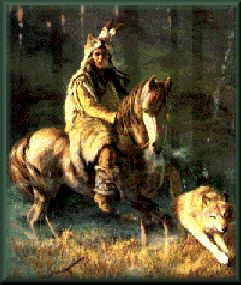
Wolves and Native Americans began as kindred creatures, both highly social beings that lived of the hunt and depended upon ritual to keep order. The two hunted together, and their spirits touched!

Recovery
Today the the eastern timber wolf survives in only 3 percent of its historic rangein the United States. Its future hinges on a remnant population of about 2,000 wolves near Lake Superior in Minnesota and about 200 wolves scattered throughout northern Wisconsin and Michigan's upper peninsula. Establishing a strong geographically separarte population would return the eastern timber wolf to more of its historic range and make its future more secure. And since scientists have recenly determined that the Great Lakes wolvews may be genetically distinct, Defenders believes the imperative to restore the wolves to the northeast is much stronger than ever before. Sites in northern Maine and New Hampshire,eastern Maine, and New York's Adirondack State Park are possible sites for eastern timber wolf reintroduction selected by the U.S. Fish and Wildlife Service. Defenders are urging serious consideration for reintroduction into the Adirondack State Park, as well as advocates careful study of the other areas for reintroduction. Returning the timber wolf to these areas would not only protect the wolf, but would enrich the quality of these ecosystems.

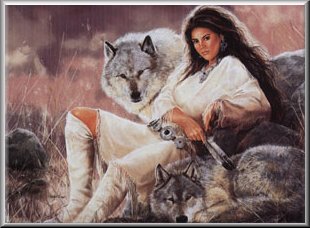
Living In Harmony

Why Restore Wolves?
Why restore the wolves you ask? Wolves benefit the ecosystem. They play an important role in preserving diverse plant and animal life by virtue of being top carnivores. Because they are wide ranging animals, ensuring the resources for their survival will ensure the survival of a great number of other species. Reintroduction of the wolves will also likely displace a large percentage of the coyote population and wild dogs, which in turn could reduce the predation on deer, and reopen niches for smaller carnivores that have been out competed by the coyote and wild dog.

Reintroducing the wolves, benefits we two legged animals economically, by adding an allure to the wilderness that few people can resist. Nearly everywhere wolves exist, regional economies have seen significant increases in tourist generated income. This is evdenced by the fact that every year thousands of people tour Algonquin Park in Ontario, Canada with little chance of seeing a wolf. Yet, each summer they come by the thousands with the hopes of hearing a wolf's howl. Each year Park Rangers conduct Howling events that regularly attract up to 500 cars filled with eager wolf enthusiasts. In North Carolina (where red wolves were reintroduced ten years ago) and Yellowstone National Park (where timber wolves were reintroduced), an increase of four to ten percent in tourism was seen which yielded millions of dollars for the local communities. Adding a charismatic and majestic species like the wolf to the Adirondack's diversity of wildlife would no doubt have similar effects on the local economies.

While wolves have been gone for one hundred years, the importance of their loss has only begun to be relized in the last two decades. many ecologists fear that the negative impact we have seen are only the tip of the iceberg and that the full impact of extirpation of wolves may not be realized for generations to come. Heavily Populated areas may never support wolves again, we have an obligation to our environment, to our generations to come, and most importantly to the wolf to seek out the remaining wild areas which can still provide a stronghold for a beautiful, majestic, and misunderstood creature, The wolf.


The Pack

Favorite Quotes
In Gods Wilderness
Lies The Hope of the world
The Great Fresh, Unblighted,
Unredeemed Wilderness
John Muir

Let Us Walk Softly On This Earth
With All Beings Great And Small,
Remembering As We Go,
That One God, Kind and Wise,
Created All
Indian Blessing

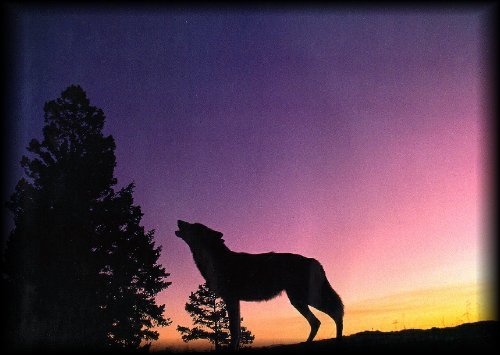
Sunset Serenade

"We Will Be Known By The Tracks We Leave Behind.."
Dakota Proverb

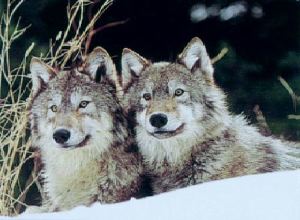
Mates for Life

Myth VS Fact
Myth: Wolves are dangerous to humans.

Fact: There is no record of a wild wolf killing a human in the history of
the United States.

Myth: Wolves will eliminate or substantially reduce prey species in New
York.

Fact: Scientists predict wolves will have only a modest impact on prey
populations. Initial studies indicate that if wolves were re-established in
Adirondack Park, the impact on deer population would be relatively
minor,affecting only 2 to 7 percent of the deer population. And with Park
winter mortalities of 12 to 18 percent, wolf kills wolf kills are notlikely
to be additive(that is, in addition to winter mortality), as many of the
deer killed by wolves are likely to be the weaker and most vulnerable to
harsh winter conditions anyway. In the five continental states with
growing wolf populations, hunting license sales and deer harvests have
steadily increased, indicating the wolf has had no adverse impact on prey
populations. In fact, the presence of wolves may actually improve prey
animals by removing inferior animals from the populations.

Myth: Farmers will suffer economic hardship as a result of wolf recovery.

Fact: Livestock loss in northwestern Montana, where wolves have been
present for over 10 years, and in Minnesota, where there are about 2000
wolves, are extremely low a fraction of one percent in both regions.
Moreover, Defenders of Wildlife has a $100,000 Wolf Compensation Trust
that pays fair market value for verified livestock losses to wolves.
Defenders has committed to extend this compensation fund to New York.

Myth: The Endangered Species Act prevents the control of wolves that prey
on livestock.

Fact: Both "endangered" wolves(such as those in northwestern Montana)
and "threatened" wolves(such as those in Minnesota) are routinely
controlled when they prey on livestock by the United States Department
of Agriculture's Animal Damage Control units. If wolves are re-introduced
into the Adirondack Park, they will not fall under full endangered
species protection, but rather a special designation that allows
land-owners more flexibility in controlling problem animals.

Myth: Wolf recovery will require land acquisition or land use restrictions.

Fact: There is no need for the State to acquire more land in order to
restore wolve to New York. Additionally, recovery of wolves in the
Northeast would contain no restrictions on land use.

Myth: Most people in the Northeast oppose wolf re-introduction.

Fact: A recent poll by by Responsive Management, Inc., a well-respected
polling firm, demonstrated that three out of four, or 76% of, Adirondack
Park reidents support the proposed re-introduction efforts. Among New York
residents statewide, support for re-introduction was 80%, and in New
England support was 84%. Other polls taken throughout the United States
consistently demonstrate that more people support wolf recovery than oppose
it.

Myth: Wolves will spread disease.

Fact: The incidence of rabies in wolves is extremely low, and has typically
been limited to arctic environments. While wolves can contract rabies, they
tend not to, and those that do die quickly rather than passing the disease
along to humans. Aditionally, all re-introduced wolves will be checked for
disease and vaccinated.


Crossing

Call of the Wild
He's been worshiped
And he's been feared,
He's been pushed from state
to state thru the years.
But now we know him
Now we understatnd,
The fragile balance
Between nature and man.

He' the call of the wild
with a spirit strong and true,
And each and every child
Should have a chance
To listen to the call of the wild.

Brother to brother
Father to son,
Have told the stories
Of this nobile one.
Proud as an eagle
And free as the wind,
And you can hear him
If only you listen.

You'll hear the call of the wild
With a spirit strong and true,
And each and every child
Should have the chance
To listen to the call of the wild.

Please let them hear
The call of the Wild.
Author Unknown


Ever Vigilant

Crying For Help
Running, hunting, trying, surviving, and dying.
The wolves have no home anymore, thats why they are crying.
For Miles and miles howls are heard discussing their fates.
Humans dont care for this animal; wolves are forgotten then killed.

Humans don't know wolves have no hates.
That's why a wolf doesn't end up at Hell's gates.
Dark night color blue; wolves' images are relived on 14 Karat gold plates.
The round moon is the only light they see.

Humans keep destroying a beautiful home.
Wolves aren't dumb; they know they have no place to roam.
At night is the call of the wild.
Something pure on this Earth; like a newborn child.

Cool air, water, and snow once demolished their fear.
There is nothing out there anymore; nothing but tears.
An innocent dream, turned black in the darkest clear...
For fire now dwells on the western land.

A newborn wolf pup sees his life has been altered.
No soft land to comfort your paws-only land of concrete and people.
Civilization to you.
No home, No Hope, No Life; but great sadness and fear.
Why can't the kingdom of salvation take them home.
Anonymous


Warriors

"Thousands of tired, nerve-shaken, overcivilized people are beginning
to find out that going to mountains is going home; that wilderness is a
necessity; and that mountain parks and reservations are useful not only as
fountains of timber and irrigating rivers but as a fountain of life"
John Muir,"The Wild Parks and Forest Reservations of the West,"
Atlantic Monthly, January 1898


Night Song

"We Are part of the Earth and the Eart is part of us.
Humankind has not woven the web of life. We are but one thread within it.
Whatever we do to the web we do to ourselves. What ever befalls the Earth
befalls also the children of the Earth."
Chief Seattle, 1856

"Not every thing that can be counted counts...
And not everything that counts can be counted."
Albert Einstein


Assembly of the Pack
"For the strength of the Pack is the Wolf.
And the strength of the Wolf is the Pack".
Rudyard Kipling

The Wolf Pack
Many different labels and connotations leap to the forefront
of peoples minds when the word wolf is spoken. Many see a wild killer preying
on the weak, where others see an animal on top of a hill howling at the moon.
Some of us two legged creatures, like myself see the loyalty to the pack.

Contrary to what many people believe, the wolf is a very social creature.
Tales of a lone wolf wandering the earth alone and howling at the moon, are
exactly that,tales. The pack usually consists of 3 to 8 wolves depending on
the species, who have strong ties to each other. The pack is a social group
within itself. In each pack there is an Alpha Male and Female who are
normally the the strongest, largest,and most dominant of the pack. They are
also, in most cases the only ones in the pack that mate. The main duties of
the Alphas are movement of the pack, settling conflicts btween pack members,
and patrolling their territorial boundries.

The second in status of the pack are the majority of the rest of the wolves.
And below them are usually the outcasts. The outcast is generally shunned
away from the pack and lives off the leftovers left by the rest of the pack
The entire social structure of the pack is set forth and maintained by the
wolf's complicated body language. It consists of numerous movements or
positions of the tail, ears, mouth and body. Wolves also let the rest of
the pack know status and mood by way of vocalization.

Wolves usually have one litter of pups a year. Mating usually takes place
around February and in April 5-6 pups are born. They are nursed for 6 weeks
while the rest of the pack helps feed the mother and her pups. The adults
regurgitate food or carry it into the den in their mouths for the mother and
pups to eat.

Wolves generally hunt at night in populated areas and elsewhere by day.
They have long legs and powerful muscles that help them run long distances
and when hunting the wolf can cover up to 40 miles in one day! Like people,
wolves have different voices, or howls. Howls are used to call the pack to
assembly or to let others know their territory. They have extremely acute
senses of sight and hearing but they mainly hunt using their sense of smell
and chase down their prey in the open.

The wolf has no natural predators. None that is...except for...
MAN


Meet Rittle my Adopted Homepage Guardian. He is a young wolf who still has some things to learn but he is a good page guardian. He is said to be a bit mysterious and can grant wishes. He is my good luck charm.

Galleries
 Visit Page 2 Visit Page 2


The Whitewater Rafting Gallery


Visit my neck of the Woods

Web Rings





LINKS





"Reference to the Wolf"

Awards

This Award was graciously given to me by SacredWolfDreams

 Graciously given to me by Connie at
"Reference to the Wolf"
Graciously given to me by Connie at
"Reference to the Wolf"

 Try the adventure Try the adventure

|